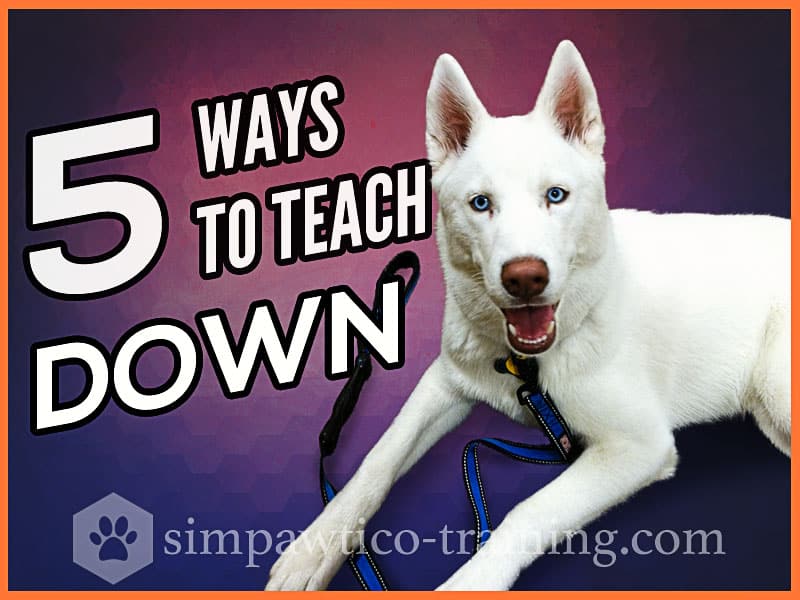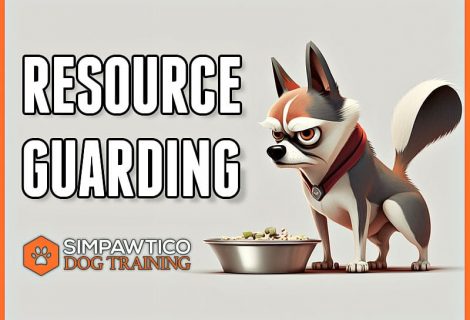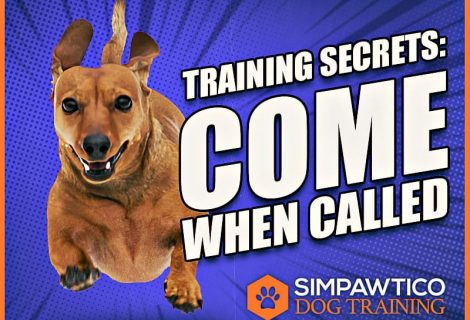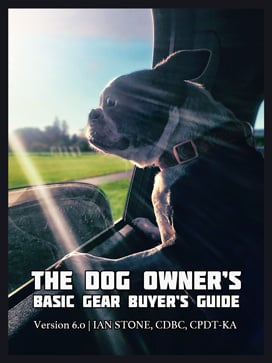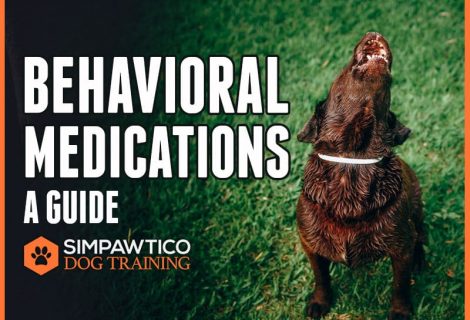Teach a Dog to Lie Down – 5 Alternate Methods
Teaching a dog to lie down is one of those basic behaviors we strive to teach every dog in the first few weeks that we have them. It’s one of the three basic positions, along with Sit and Stand. And it’s a wonderful way to settle a dog down or to have them Stay for an extended period. Lying down is a little special, though. Most dogs will pick it up immediately with a basic lure-reward training routine. But other dogs can struggle with the concept. For example, certain breeds, such as Boston Terriers and Yorkies, sometimes seem totally baffled by Down. So, to help you out, here are five strategies to teach the Down position to your dog:
STRATEGY #1: LURE REWARD TRAINING
This is the most straightforward method and the first one you should try. All lure-reward training behaviors follow the same 1234 formula:
- Request
- Lure
- Response
- Reward
In this case, that looks like this:
- Say “Down.”
- Use food to lure the dog’s nose down between the front paws.
- Your dog should collapse into a lying down position.
- Immediately mark, praise and, reward your dog the exact moment they hit the position.
Most commonly, this is started from a sitting position since half the dog is already in the right place. That’s OK, to begin with, but as soon as you can get ten in a row, start trying it from the standing position. Your dog should be able to lie down from sitting or standing without any unnecessary steps.
Make sure you start fading the lure as soon as you can!
Although lure-reward training is the first thing you should try, sometimes it takes a little bit more to crack this nut. That brings us to…
STRATEGY #2: BUILDING from a BOW
This is lure-reward training too, but we’re taking a different approach to the luring bit. Stand or kneel to the side of your dog and, using the food lure, move in between the front paws at an oblique, 45º angle. The point is to get them into the same position as a play bow. Once you’re getting the bow consistently, start dialing it in. Build repetitions.
Then, start pausing between the front feet. It won’t take long for the bottom to plop down. Praise BIG when you get it.
Then, build more repetitions on the total down. On a side note: you could make this “take a bow” and then shape it to be “Down” and still have both available as behaviors.
STRATEGY #3: SHAPING from the NECK
Sometimes, a dog won’t be able to figure out what the expectation is and will give up quickly. If luring doesn’t seem to work to get the dog all the way down, break the behavior down into smaller pieces. Perform the luring action as before but reward initially for just lowering the head down to get it. As consistency builds, ask your dog to go further and further with it until they lie down.
This time-consuming method can take several days, but I’ve done it before with stubborn dogs. When they finally lie down, boy, you’d better make a big fuss about it!
STRATEGY #4: ALL-or-NONE REWARD TRAINING (aka the “BATHROOM DOWN”)
All-or-None Reward Training is the easiest of all the methods because you don’t really have to do much.
- Get about 20 or so food rewards and something to read.
- Pick a small room, such as a bathroom or walk-in closet, and close yourself inside with your dog.
- Have a seat and start reading. Pay no mind to your dog; just do your own thing.
- Your dog will eventually get bored with sniffing the corners and lie down.
- Immediately praise this behavior, and toss a treat so your dog has to get up to get it, thus setting them up to do it again.
- As the dog catches on and starts offering the behavior to get a reward, it will be simple to transition over to putting the behavior on request (or what we call “putting it on stimulus control”). Simply say the verbal cue, “Down, ” right before they do it, and reward them—piece of cake.
Be aware that once you leave the space you’ve done this in, your dog may need a bit of coaxing to realize this works everywhere. At this point, simple lure-reward training should work to get over the hump.
STRATEGY #5: SHAPING by BRIDGING
This is the last resort because it’s the most difficult and time-consuming to do. Essentially you will use a food reward to lure your dog into crawling under a bridge. This could be a stool, your leg or bent knee, or an end table…it just depends on the size of your dog. Make sure you mark the behavior as soon as the elbows and belly touch the floor. Gradually shape this behavior by removing the bridge little bits at a time. Raise your leg or knee higher, or remove the stool or chair.
Incidentally, this is how I taught Down to my Boston Terrier, Bobo. Once he got the idea, getting rid of the bridge and using lure-reward training to improve his performance was easy. Now he’s so good he’s perfectly prompt, precise, and polite.
OTHER CONSIDERATIONS
If you’re having trouble, check the floor surface. Some surfaces weird a dog out, and they resist lying down on them. Maybe it’s too slippery, uncomfortable, or just plain unfamiliar. Try a different place, or have the dog try it on a blanket, a towel, or a bath mat. When they get the idea, you can transition to other surfaces with lots of practice and praise.
Also, think of ways you can set yourself up for success. For example, you could practice down after a long walk or after playtime. These are instances when the dog is more inclined to lie down anyways to rest. Don’t forget to start phasing out the food lure as soon as possible. Once you’ve got lay down pretty well dialed in, get that food lure out of your hand and into your pocket.
Remember: a lure is given to cause behavior. Once the behavior is happening reliably, we don’t need it. A reward, then, comes after the behavior, like magic. It’s not guaranteed or promised. In contrast, a bribe is used before the behavior to coerce them to perform. This is not how it should be done for the long term. It’s all about repetition, clear goals, and consistency.
FINALLY
As always, be patient and encouraging as your dog figures out the Down position. Remember teaching your dog things is a team sport. You’re both working together. You’d cheer your kid on if they made a goal in soccer. Do the same for your dog when they hit a new accomplishment. Show enthusiasm and encouragement. You can do a lot when you do it together!
Please read my article on how to build compelling reward-events to learn more!
So, good luck nailing this if your dog is having some trouble. Relax, and don’t give up. It will get there.
Questions for you: Which one of these approaches stood out to you the most? What tips do YOU have? And what are some other training conundrums you’d like me to help you with? Let’s connect in the comments below.
As always, keep learning, and keep practicing!


